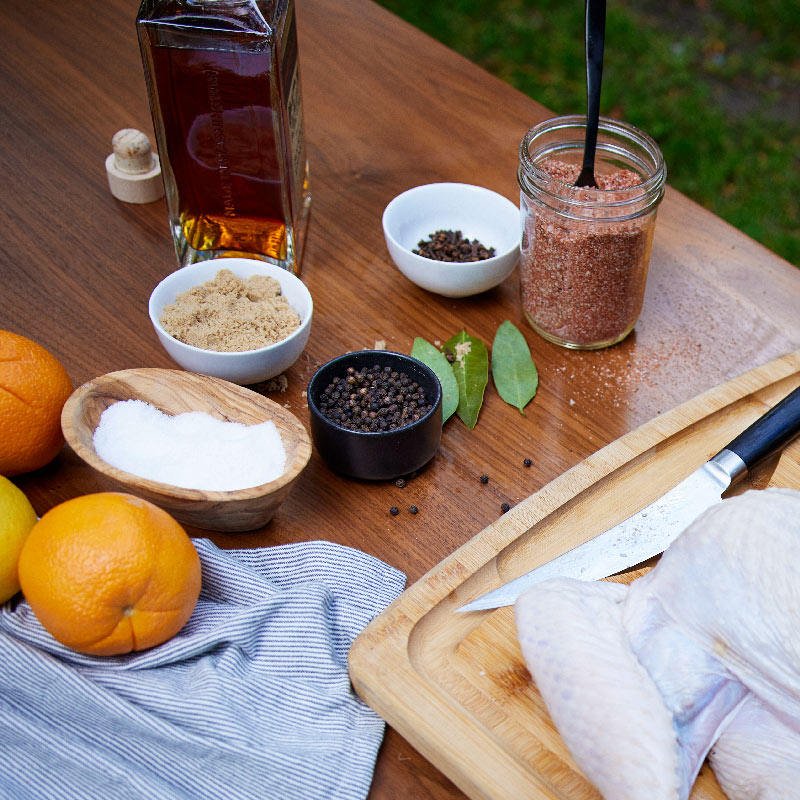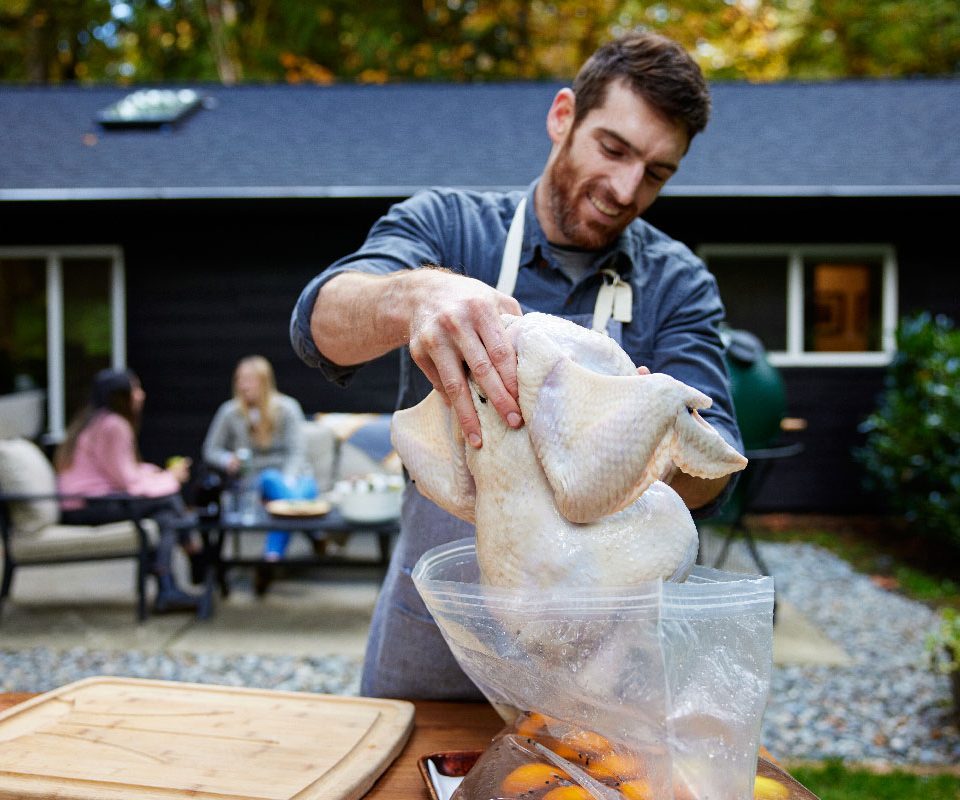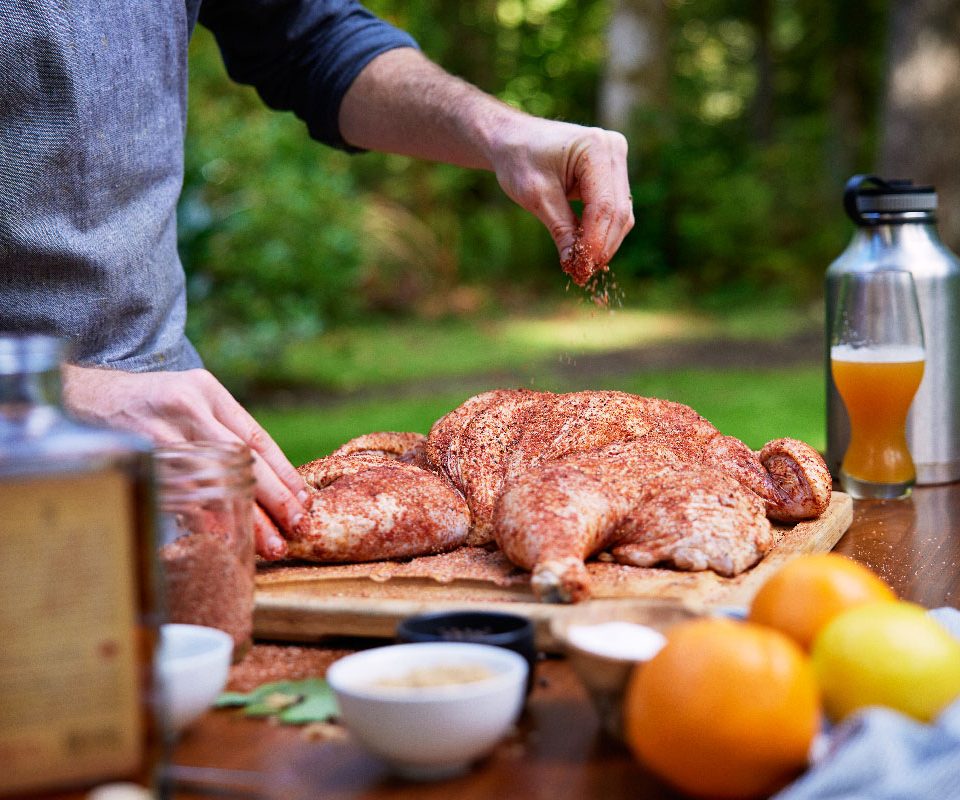Brining Basics
How to cook the holiday turkey used to be such a simple decision. You roasted it in the oven until that little timer popped up, and often ended up with a seriously dry bird (which is probably why gravy was invented!)
And then along came the EGG, and everything you came to know about the Thanksgiving centerpiece changed! Why roast the turkey in the oven when you can add delicious live-fire flavor to the bird by roasting or smoking it in the EGG. You’ll also need to decide whether to stuff the bird, inject it, or get adventurous and brine it.
Is Brining a Turkey Worth It?

The idea behind brining food is relatively simple. Immersing poultry (and don’t forget seafood and pork chops!) in salt-based, savory solution before cooking enhances the flavor and tenderness of your food. For poultry, either a dry or wet brine can include a variety of flavors including citrus, herbs, sugar and spices.
But, the biggest advantage of brining a turkey is the juiciness, forever doing away with a dry bird. In fact, brining is mostly commonly used for lean meats that are prone to being overcooked and dry.
Wet Brining vs Dry Brining
Wet Brining
Wet brine is the process of submerging meat into a solution of salt and water. Brining adds flavor from the inside out and tenderizes the meat. Some of the liquid is trapped on the inside of the meat creating a moister and juicer piece of meat.
For a traditional wet brine, all that is needed is water and salt, in a proportion of one tablespoon of salt for each cup of water. The amounts will differ per the weight of the meat. To create a wet brine, it’s as easy as combining the salt and water together.
To add more flavor into the brine, try adding some of the following ingredients:
- Sugar, brown sugar or molasses
- Bourbon
- Juices
- Chicken broth
- Fresh herbs
- Citrus peels
- Soy sauce
- Worcestershire
- Garlic
- Onion
Wet Brining Tips

- When using a wet brine, make sure the meat is completely submerged in the solution. Make sure there is room in the refrigerator for the container before you start the process. Refrigerate the meat if brining time is over 30 minutes.
- It’s best to let the meat dry, or pat it dry with paper towels, after brining to keep it from steaming.
- When adding ingredients other than salt, the brine will need to be heated, so all the ingredients can be combined. These additional ingredients will make the brine smell great and give flavor to the outside of the meat, but it will not penetrate to the interior of the meat. If heat is used, be sure to cool the brine completely before placing the meat in the solution.
Time Guide for Brining Meat
Since brines are a salty solution, they work very quick. Generally, meat should be brined for about one hour per pound. It is easy to over-brine, which leads to mushy meat, so be very cautious about timing.
| Meat | Approximate time |
| Shrimp | 15 to 30 minutes |
| Fish fillets | 10 to 30 minutes |
| Whole fish | 1 to 3 hours |
| Boneless poultry | 30 minutes |
| Bone-in poultry, cut-up | 1 to 2 hours |
| Whole poultry | 4 to 12 hours |
| Boneless pork chops | 30 minutes |
| Bone-in pork chops | 30 minutes to 1 hour |
| Whole pork tenderloin | 1 to 2 hours |
| Whole pork loin | 2 to 12 hours |
Dry Brine
Dry brining is the process of rubbing salt, seasonings, or sugar, without water, on the exterior of the meat, and then letting the meat rest in the refrigerator for a before cooking. By not adding water there is no excess moisture diluting the meat’s natural flavors. The salt draws out and infuses with the meat’s natural juices, creating flavors that are more concentrated. This infused-brine is then reabsorbed into the meat and starts breaking down tough muscle proteins, resulting in juicy, tender, savory meat.
For a traditional dry brine, all that is needed is kosher salt – 1½ teaspoons for each pound of meat. To add more flavor into the brine, try adding some of the following herbs:
- Thyme
- Sage
- Rosemary
- Black pepper
- Parsley
- Garlic
- Paprika
- Cloves
- Sugar

After creating your dry brine, pat the outside of the turkey dry with paper towels. Loosen the skin over the breast and the meaty part of the legs. Season the cavity of the turkey and underneath the skin of the breast and legs. Rub the remaining salt mixture over all the outside of the turkey.
